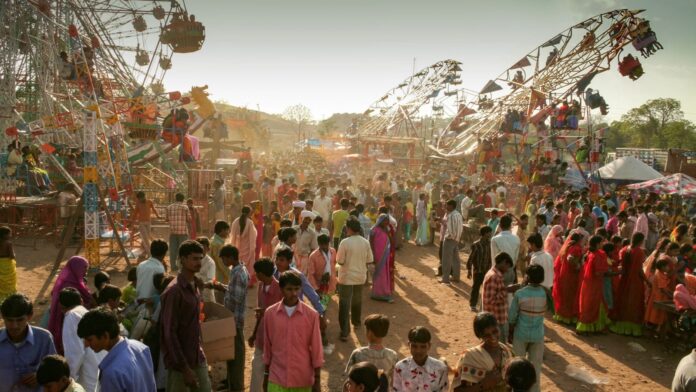Last Updated:
India is helping its people shift from dependency to dignity. Apart from being a social victory, this is a profound economic catalyst as well

In 2011-12, over 27 per cent of India’s population languished in extreme poverty. Today, that figure has shrunk to just 5.3 per cent. (PTI Image for Representation)

For long, India was considered a country of snake charmers. A country which the colonisers thought would crumble under the weight of its own problems as a free nation, destined to hold a begging bowl before the world. A country which, in the eyes of many Western observers, simply did not have what it takes to become a developed nation in a short span of time. Today, India is proving the naysayers wrong as it continues on the path of economic development with one landmark goal in mind—to fully develop by 2047. While the world faces continuing economic uncertainties, India is reinforcing its position as a global bright spot.
Recommended Stories
The evidence for this turnaround is not anecdotal; it is backed by rigorous data from global institutions. Consider what the World Bank has revealed in its latest report. Even after raising the poverty line to a more realistic $3 per day to reflect inflation and purchasing power parity, India has managed to lift an astonishing 171 million people out of extreme poverty in the last 10 years. To put that number in perspective, it is more than the entire population of Russia.
In 2011-12, over 27 per cent of India’s population languished in extreme poverty. Today, that figure has shrunk to just 5.3 per cent, which is a remarkable turnaround for hundreds of millions of ordinary Indians. The cherry on top? India’s poverty alleviation efforts are yielding results across demographics and regions, addressing long-standing structural inequalities.
For example, rural extreme poverty fell dramatically from 18.4 per cent to 2.8 per cent, while urban extreme poverty came down from 10.7 per cent to just 1.1 per cent. Crucially, the rural-urban poverty gap narrowed from 7.7 percentage points to 1.7 points, indicating that the fruits of development are not being hoarded by a few urban centres but are reaching the hinterlands. This is a sign of inclusive, balanced and socially equitable growth.
This progress is the outcome of a deliberate and focused strategy for poverty alleviation. The approach under Prime Minister Narendra Modi has been clear: empower people to stand on their own feet, while also providing a robust safety net to support them for as long as necessary. This ensured a sustainable and lasting exit from poverty. This potent model of welfare with empowerment has set a new global benchmark. The government’s free food grain programme, which supports 800 million individuals, acted as a critical safety net against economic shocks, especially during the pandemic, ensuring basic food security on a scale the world has not seen before. The use of technology like Direct Benefit Transfers (DBT) has been pivotal in ensuring these benefits reach the intended recipients directly, plugging leaks that historically plagued welfare schemes. Of course, this would not have been possible without the financial inclusion of crores of Indians with the formal banking sector, which was one of the first things PM Modi set out to do when he took office.
In fact, India’s achievement becomes all the more significant when placed in a regional context. While India has made significant strides, the situation in Pakistan offers a stark contrast. According to the World Bank’s latest projections, nearly 45 per cent of Pakistan’s population lives in poverty, with 16.5 per cent in extreme poverty. The Bank’s April report noted that the country’s 2.6 per cent economic growth, hampered by high inflation and debt, “remains insufficient to reduce poverty”. It projects the poverty rate to stand at 42.4 per cent in FY25, which translates to an additional 1.9 million people falling into poverty this year alone. The divergent paths of the two nations, born from the same history, could not be more evident.
Yet, this achievement is often not fully appreciated within India itself. The prevalence of misinformation, particularly on social media, can project a distorted image of the country that overshadows real progress. This is a moment that calls for critical thinking and an objective assessment of the facts. It is a civic responsibility to look beyond curated outrage and seek primary sources. If an international body like the World Bank can analyse the data and see clear evidence of large-scale poverty reduction, then it is certainly information worth considering for Indians at large.
The push for development and welfare has been comprehensive, touching every aspect of a dignified life. It includes providing access to toilets through the Swachh Bharat Mission, enhancing connectivity with a robust network of new roads and railways, and expanding access to clean cooking gas with the Ujjwala Yojana. It is about providing homes for millions through the PM-Awaas scheme, ensuring electricity reaches every village, offering a healthcare safety net with Ayushman Bharat, and encouraging small-scale entrepreneurship through the Mudra Yojana.
India is helping its people shift from dependency to dignity. Apart from being a social victory, this is a profound economic catalyst as well. Lifting 171 million people out of poverty means creating 171 million new consumers and potential producers. As families move beyond subsistence, they begin to participate more fully in the economy. They buy soap, clothes, and mobile phones. They save for their children’s education. They aspire to own a two-wheeler. This surge in domestic demand creates a virtuous cycle of production and consumption.
This is happening at a pivotal moment, when there is a renewed focus on Indian manufacturing. Initiatives like “Make in India” and the Production-Linked Incentive (PLI) schemes are designed to turn India into a global manufacturing hub. But any such ambition requires a vast, capable, and aspirational workforce. The millions who have recently escaped poverty are that workforce—factory workers, logistics handlers, and the small-business owners of tomorrow. Their improved health and access to education make them more productive, and their newfound economic security makes them active participants in national growth. The strategic alignment of social welfare policy with economic ambition is creating a powerful engine for progress. The old and tired image of India is being replaced by the reality of a nation making measurable and life-altering progress.
Views expressed in the above piece are personal and solely those of the author. They do not necessarily reflect News18’s views.
About the Author

Sanbeer Singh Ranhotra is a producer and video journalist at Network18. He is enthusiastic about and writes on both national affairs as well as geopolitics.
Sanbeer Singh Ranhotra is a producer and video journalist at Network18. He is enthusiastic about and writes on both national affairs as well as geopolitics.
- Location :
- First Published:
News opinion Straight Talk | Data Doesn’t Lie: India’s Poverty Decline Stuns The World



